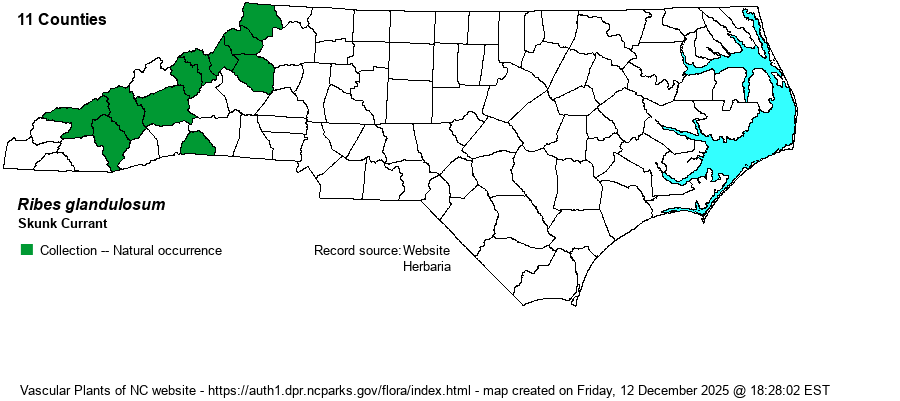| Author | Grauer | |
| Distribution | Limited to quite high elevations (mostly over 4500 feet) in the Mountains, southwest only to Jackson and Swain counties.
This Northern species occurs across much of Canada, and south to northern NJ and southern WI, then in the Appalachians to southwestern NC and adjacent TN. It is not yet known for KY or GA.
| |
| Abundance | Infrequent to locally fairly common, almost always above 4500 feet. The least numerous of the three Ribes species in the state, but certainly not a scarce species. | |
| Habitat | This is a characteristic shrub of high elevation boulderfield forests, but it also occurs in spruce and fir stands, often mixed with hardwoods, as well as high elevation seepages in such forests, particularly where rocky. Such sites are almost always moist with a cool/cold microclimate. |
| Phenology | Blooms in May and June, and fruits from July to September. | |
| Identification | This is a rather unusual deciduous shrub, in that it is a sprawling or leaning species with long branches, but reaching only several feet tall. As it usually occurs in rocky places, walking or scrambling through such a habitat is often made more difficult when this shrub is present. It has typically unarmed branches with alternate maple-like leaves, which are noticeably wider than long. The lobed leaves average 3-4 inches wide and somewhat less long. There are several small whitish flowers from axils, and the round red fruit is rather bristly, but not as much as is the fruit of R. cynosbati. Normally, however, you should be able to identify this species by its sprawling form and its wide maple-like leaves, without seeing flowers or fruit. All parts of the plant give off a skunk-like odor when broken or crushed. | |
| Taxonomic Comments | None
| |
| Other Common Name(s) | Mountain Currant | |
| State Rank | S3 | |
| Global Rank | G5 | |
| State Status | | |
| US Status | | |
| USACE-agcp | FACW link |
| USACE-emp | FACW link |

